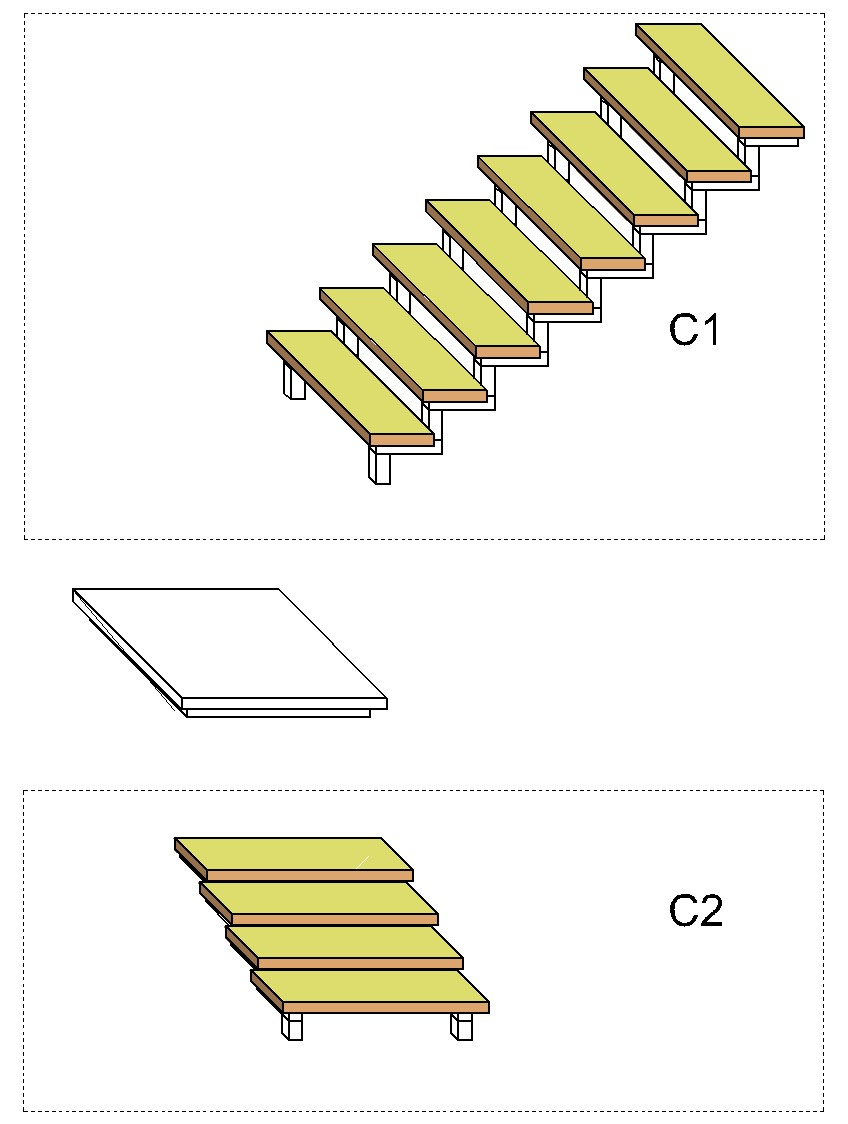3D L-shaped steel stair calculator: saw-tooth stringers type
Instructions

Fig. 1 General drawing of the staircase
Y – the height of the opening (total rise) – usually determined by the distance between the floors in your house.
X – width of the opening (total run) – depends on how much space you can allocate in your house for the staircase.
W – staircase width.
Z – thickness of steps – usually is a geometric parameter of the material (e.g. boards) from which you plan to build the steps.
F – stair nosing – a distance at which the upper step will hang over the lower one.
A – thickness of a stringer – a geometric parameter of the material (e.g. metal tubes) from which you plan to build the stringer.
G – width of a stringer – a geometric parameter of the material (e.g. metal tubes) from which you plan to build the stringer
C1 – number of steps on the upper part.
C2 – number of steps on the lower part.
T – number of stringers.

Fig. 2 Staircase parts
You will select number of steps for the two parts described on the drawing.

Fig. 3 Different number of stringers
The number of stringers can differ.
Function “Top stair is below the floor: SP”

Fig. 4 Top stair is below the floor
Depending on the placement of the staircase you can chose either:
- The upper step is on the same level with the floor plane;
- The upper step is below the floor plane.
SP parameter may depend on:
- the thickness of the floor slabs,
- the desired relationship between the number of steps and their height,
- the length of the stringers and the length of the opening,
- the desired angle (slope) of the staircase,
- or simply a preference of the house owner.
Note, in the figure where the upper step is below the floor, the thickness of the plane is greater than in the figure where the upper step is on the same level with the floor plane. Thus visualisation suggests that thickness of the floor plane should be great enough to allow the stringer to connect properly.
Function “Drawing in black and white”

Fig. 5 Black and white drawing of the staircase
This function is normally used for printing in greyscale.
Function “Change staircase direction: LR”

Fig. 6 Different staircase directions
This function helps to visualise the staircase in a convenient for you way. A particular direction does not affect calculation results.
What for is this calculator?
Helps to construct your staircase in a more precise manner
- Information required for construction of staircase stringers, frames and landing.
- Information required for building of stairs.
This information serves to precisely construct the staircase parts, gives necessary parameters to construct staircase frame and steps.
All other drawings show the final form of the staircase, i.e. after connecting stringers and stairs with each other. Rise and run calculation is shown on the drawing in results.
Helps to determine how comfortable your staircase will be
Every calculator on this website will allow you to:
- Assess convenience of your staircase design;
- Adjust the staircase parameters given the suggestions you will get.
The assessment of the staircase convenience is carried out according to the three criteria:
- Correspondence of the staircase to the average human step length. According to this criterion, sum of a step (tread) width and two step rises should be equal to the average human step length, which is 63 cm.
- Step (stair tread) width is important. A comfortable step width, which equals to step run + step nosing, is about 28 cm. You can regulate the step width by changing the nosing.
- The stair angle (slope) is crucial. The optimum angle ranges from 30° to 40°. If instead stair angles range from 20° to 30° and from 40° to 45°, the level of comfort will be significantly reduced. Such angles beyond/above the optimal limits can significantly affect the speed of movement and the level of safety of the stairs.
After you fill-in the initial parameters and press “Calculate”, an indicator of the level of convenience for each criterion will be given. Furthermore, general level of convenience is calculated.
Every stair calculator on perpendicular.pro will give you practical advice on how to improve the level of comfort of your staircase. The following will be suggested:
- Decrease / increase number of steps;
- Increase the step width (in case if the depth of the steps is not sufficient for comfortable walking);
- Decrease / increase the length of the opening (total run).
Usually the height of the opening is already set. Based on your own preferences, you can choose the level of convenience: either the criteria of convenience are met, or the stairs are flatter, or steeper, etc.
Although the calculator evaluates whether the staircase meets common criteria of convenience, you should always remember that your staircase should serve your purposes. Thus, if you really need to build the most non – standard staircase in the world, then go for it!
Maybe you are looking for a different staircase type?
perpendicular.pro has more to offer:
Calculators of staircases with wooden (or similar material) stringer:
- 3D Simple stair calculator
- 3D Simple stair calculator: saw-tooth stringer
- 3D L-shaped stair calculator
- 3D L-shaped winder staircase calculator
- 3D U-Shaped staircase calculator
- 3D U-shaped winder staircase calculator
- 3D U-shaped quarter landing stairs calculator
- 3D Doble winder staircase calculator
Calculators of staircases with steel (metal) stringer:
- 3D Steel stair calculator
- 3D Steel stair calculator: saw-tooth stringers type
- 3D L-shaped steel stair calculator
- 3D U-shaped steel stair calculator
- 3D U-shaped steel stair calculator: saw-tooth stringers type
Other types:
We hope this information was helpful!




Comments: